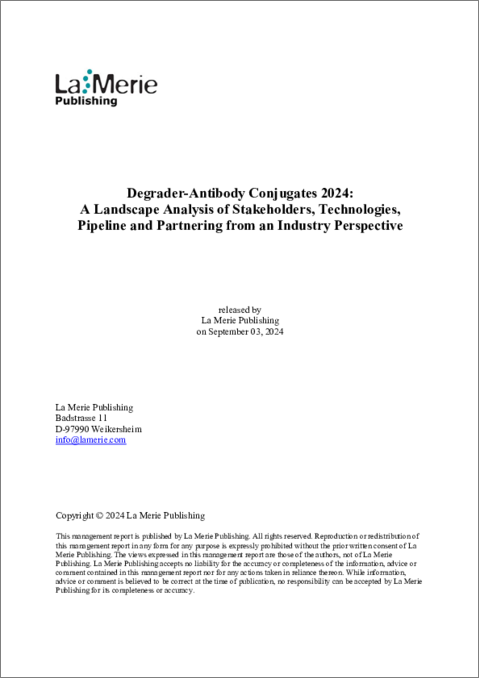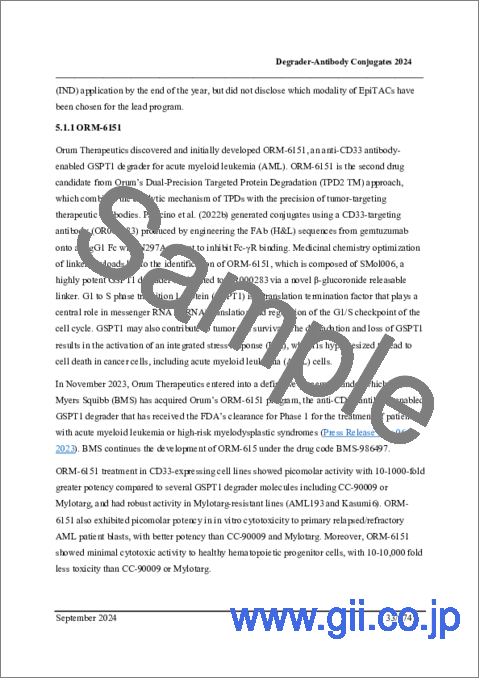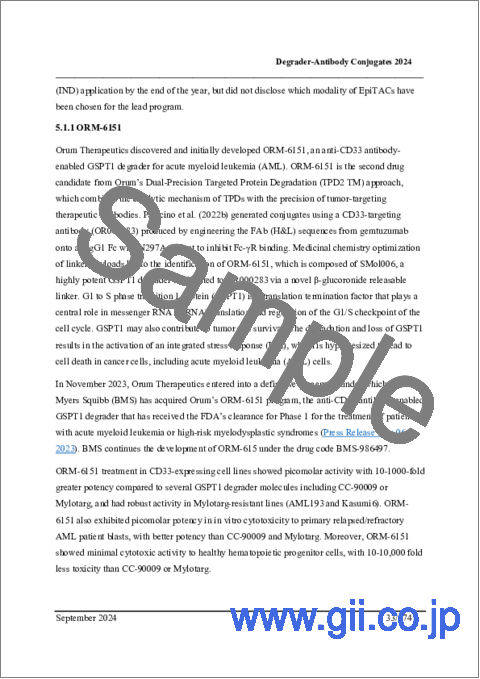|
|
市場調査レポート
商品コード
1548965
分解抗体複合体 (DAC) の世界市場:業界の観点から見たステークホルダー・技術・パイプライン・提携の情勢分析 (2024年)Degrader-Antibody Conjugates 2024: A Landscape Analysis of Stakeholders, Technologies, Pipeline and Partnering from an Industry Perspective |
||||||
|
|||||||
| 分解抗体複合体 (DAC) の世界市場:業界の観点から見たステークホルダー・技術・パイプライン・提携の情勢分析 (2024年) |
|
出版日: 2024年09月03日
発行: La Merie Publishing
ページ情報: 英文 174 Pages
納期: 即納可能
|
全表示
- 概要
- 目次
当レポートでは、2024年9月時点の業界情勢から、DAC (分解抗体複合体) の利害関係者、プラットフォーム技術、開発・探索パイプライン、提携案件を解説・分析しています。新たな新薬であるDACは、抗体薬物結合体 (ADC) と標的タンパク質分解剤という既存技術の融合であり、両技術の長所を組み合わせ、限界を回避することを目的としています。DACは、抗体の特異性と、薬物化が困難なタンパク質標的分解剤の効率性を組み合わせたものです。DACは、ADC企業にとっては有効性と治療域を改善するために新規のペイロードを使用する機会を、標的タンパク質分解 (TPD) 企業にとっては細胞特異性・半減期・薬物様特性を改善する機会を数多く提供します。
DAC治療薬の2つの主な用途は以下の通りです:
- 細胞内標的タンパク質分解
- 細胞外標的タンパク質分解
当レポートでは、以下の最新情報と分析をお届けします:
- 製薬企業やTPD技術企業におけるDAC活動の企業プロファイルに基づく、この分野の利害関係者;
- 細胞内TPDのためのプロテアソーム分解向けPROTAC・分子接着剤を用いたDAC技術;
- 細胞内分解の対象となるタンパク質;
- 細胞内分解に使用されるE3リガーゼ;
- 細胞外TPD向けに広範に作用する分解剤を用いたDAC技術;および
- リソソーム経路分解剤を用いたDAC技術;
- DACの臨床・非臨床開発パイプライン;
- 臨床段階にあるDACのプロファイル;
- DACの創薬パイプライン;
- DACの結合技術と構成概念の前臨床概念実証;
- 提携活動 (買収、ライセンシング、共同研究)
DACの最初のコンセプトは、DACを腫瘍標的抗体とPROTAC (タンパク質分解標的キメラ) を化学的に結合させたものと定義しています。PROTACは大型のヘテロ二機能性低分子で、1つの部分はリンカーを介して細胞内の標的タンパク質 (PoI)、例えばブルトン型チロシンキナーゼ (BTK) と結合し、2つ目の部分はPoIをユビキチン化するE3リガーゼに結合し、結果として細胞質ゾル内部でプロテアソーム分解されます。DAC探索プログラムの大部分はこのコンセプトに依存していますが、PROTACの代わりに分子接着剤を使用したDACも研究されており、臨床評価段階にある最初のものでさえあります。分子接着剤タイプの低分子は、E3リガーゼとPoIとの相互作用を増強する接着剤の役割を果たし、ユビキチン化とプロテアソーム分解を導きます。PROTACは、E3リガーゼとPoIへの結合部位が独立しているため、接着剤よりも設計が容易です。しかし、一般的にPROTACは分子が大きく、開発が困難です。一方、接着剤は一般的に分子が小さく、より薬剤に近いです。DACの範囲は現在、膜結合タンパク質や可溶性タンパク質を分解するための細胞外空間へと拡大されつつあります。細胞外標的タンパク質分解には、二重特異性生物製剤あるいは低分子が関与し、膜結合型あるいは分泌型 (可溶性) のPoIを分解機構にリクルートします。分解は、膜貫通型E3リガーゼやサイトカイン受容体を介して、あるいはPoIをリソソームへ輸送するための膜結合型リサイクリング受容体を介して起こります。
目次
第1章 エグゼクティブサマリー
第2章 イントロダクション
第3章 DACの研究開発におけるステークホルダーの分析
- 製薬会社
- テクノロジー企業
第4章 DAC技術の分析
- DAC (分解剤抗体複合体) 技術の概要
- 分子接着剤型分解剤を用いたDAC
- PROTAC型分解剤を用いたDAC
- 広範囲に作用するDAC
- リソソーム経路分解剤を含むDAC
第5章 DACの研究開発の分析
- DACの臨床・非臨床開発パイプライン
- ORM-6151のプロファイル
- ORM-5029のプロファイル
- 創薬段階のDACプログラムのパイプライン
- DAC技術・構造の前臨床概念の実証
第6章 DAC分野における提携の分析
- 企業買収
- ライセンス契約
- 創薬協力
第7章 DACの研究開発を行っている企業の概要
- 製薬企業
- Bristol Myers Squibb
- CSPC Pharmaceutical Group
- Debiopharm
- Eisai
- GlaxoSmithKline
- Merck KGaA
- Merck & Co. (MSD)
- Novartis
- Pfizer
- Pierre Fabre
- Roche
- Vertex Pharmaceuticals
- テクノロジー企業
- C4 Therapeutics
- Crossfire Oncology
- Cullgen
- EpiBiologics
- Firefly Bio
- InduPro
- Lycia Therapeutics
- NanoMedSyn
- NIBEC
- Nurix Therapeutics
- Orum Therapeutics
- Prelude Therapeutics
- Ubix Therapeutics
- VectorY Therapeutics
第8章 DAC技術のプロファイル
- AMFA
- CELMoD ADC
- Degraducer
- DELigase
- EpiTAC
- EPriL
- LYTAC & GELYTAC
- PROTAB
- PROxAb
- REULR
- TORPEDO
- TPD2
- uSMITE
- VecTron
第9章 参考文献
This report provides you with a landscape description and analysis of degrader-antibody conjugate (DAC) stakeholders, platform technologies, development and discovery pipelines and partnering deals from an industry perspective as of September 2024. The emerging novel drug modality of degrader-antibody conjugates represents the convergence of the existing technologies of antibody-drug conjugation and targeted protein degradation with the goal of combining the strengths and avoiding the limitations of both technologies. DACs combine the specificity of antibodies with the efficiency of degraders of difficult to drug protein targets. Degrader-antibody conjugates provide plenty of opportunities for ADC companies to use a novel payload to improve efficacy and the therapeutic window and for targeted protein degradation (TPD) companies to improve cell-specificity, half-life and drug-like properties.
The two main uses for Degrader-Antibody Conjugate therapy are:
- Intracellular Targeted Protein Degradation
- Extracellular Targeted Protein Degradation
The report brings you up-to-date with information about and analysis of:
- Stakeholders in the field, by company profiles of DAC activities at pharmaceutical and TPD technology companies;
- DAC technologies using PROTAC and molecular glue for proteasomal degradation for intracellular TPD;
- Proteins-of-interest for intracellular degradation;
- E3 ligases used for intracellular degradation;
- DAC technologies using broadly acting degraders for extracellular TPD; and
- DAC technologies with lysosomal pathway degraders;
- Clinical and non-clinical development pipeline of DACs;
- Profiles of clinical stage DACs;
- DAC discovery pipeline;
- Preclinical proof-of-concept of DAC conjugate technologies and constructs;
- Partnering activities (acquisition, licensing, collaborations)
The original concept of degrader-antibody conjugates defines DACs as tumor-targeted antibodies chemically conjugated to proteolysis-targeting chimera (PROTACs). PROTACs are large heterobifunctional small molecules with one part binding to the intracellular protein of interest (PoI), e.g. Brutons Tyrosine Kinase (BTK), via a linker to a second part which binds to an E3 ligase that ubiquitylates the PoI, resulting in proteasomal degradation in the cytosol. The majority of DAC discovery programs rely on this concept, but DAC using a molecular glue instead of a PROTAC are also being pursued and even are the first in clinical evaluation. Molecular glue-type small molecules act as an glue that enhances the interaction between an E3 ligase and a PoI, leading to its ubiquitylation and proteasomal degradation. PROTACs are easier to design than glues given their independent binding sites to the E3 ligase and the PoI. However, they are generally large molecules that can be challenging to develop, whereas glues are typically smaller and more drug-like. The scope of degrader-antibody conjugates is currently being expanded into the extracellular space for degradation of membrane bound and soluble proteins. Extracellular targeted protein degradation involves bispecific biologics or small molecules that recruit the PoI, either membrane-bound or secreted (soluble), to a degradation machinery. Degradation may occur through a transmembrane E3 ligase, or a cytokine receptor or via a membrane bound recycling receptor for transport of the PoI to the lysosome, which is the typical pathway for the degradation of extracellular proteins.
Methodology:
This report evaluates the industry landscape of degrader-antibody conjugation in research and development. The report provides a comprehensive overview of the R&D and partnering activities of pharmaceutical and technology companies in the field of degrader-antibody conjugates. This report is based on the identification and description of 26 corporate stakeholders: 12 pharmaceutical companies and 14 technology companies. All publicly available information is fully referenced, either with scientific references (abstracts, posters, presentations, full paper) or hyperlinks leading to the source of information, such as press releases, corporate presentations, annual reports, SEC disclosures and homepage content.
The report has four analytical chapters about stakeholders, DAC technologies, DAC R&D including pipeline, and DAC partnering. Analysis is based on information presented in the two subsequent chapters with specific profiles of companies and technologies. A list of scientific references is provided in the last chapter of the report followed by an overview of the Tables in the text.
Table of Contents
1 Executive Summary
2 Introduction
3 Analysis of Stakeholders in Degrader-Antibody Conjugate R&D
- 3.1 Pharmaceutical Companies
- 3.2 Technology Companies
4 Analysis of Degrader-Antibody Conjugate Technologies
- 4.1 Overview of Degrader-Antibody Conjugate Technologies
- 4.2 Degrader-Antibody Conjugates with Molecular Glue-type Degraders
- 4.3 Degrader-Antibody Conjugates with PROTAC-type Degraders
- 4.4 Degrader-Antibody Conjugates with Broadly Acting Degraders
- 4.5 Degrader-Antibody Conjugates with Lysosomal Pathway Degraders
5 Analysis of Degrader-Antibody Conjugate Research & Development
- 5.1 Clinical & Nonclinical Development Pipeline of Degrader-Antibody Conjugates
- 5.1.1 Profile of ORM-6151
- 5.1.2 Profile of ORM-5029
- 5.2 Pipeline of Discovery Stage Degrader-Antibody Conjugate Programs
- 5.3 Preclinical Proof-of-Concept of Degrader-Antibody Conjugate Technologies and Constructs
6 Analysis of Partnering in the Field of Degrader-Antibody Conjugate Partnering
- 6.1 Acquisition
- 6.2 Licensing
- 6.3 Discovery Collaborations
7 Profiles of Companies with Degrader-Antibody Conjugate R&D
- 7.1 Pharmaceutical Companies
- 7.1.1 Bristol Myers Squibb
- 7.1.2 CSPC Pharmaceutical Group
- 7.1.3 Debiopharm
- 7.1.4 Eisai
- 7.1.5 GlaxoSmithKline
- 7.1.6 Merck KGaA
- 7.1.7 Merck & Co. (MSD)
- 7.1.8 Novartis
- 7.1.9 Pfizer
- 7.1.10 Pierre Fabre
- 7.1.11 Roche
- 7.1.12 Vertex Pharmaceuticals
- 7.2 Technology Companies
- 7.2.1 C4 Therapeutics
- 7.2.2 Crossfire Oncology
- 7.2.3 Cullgen
- 7.2.4 EpiBiologics
- 7.2.5 Firefly Bio
- 7.2.6 InduPro
- 7.2.7 Lycia Therapeutics
- 7.2.8 NanoMedSyn
- 7.2.9 NIBEC
- 7.2.10 Nurix Therapeutics
- 7.2.11 Orum Therapeutics
- 7.2.12 Prelude Therapeutics
- 7.2.13 Ubix Therapeutics
- 7.2.14 VectorY Therapeutics
8 Profiles of Degrader-Antibody Conjugate Technologies
- 8.1 AMFA
- 8.2 CELMoD ADC
- 8.3 Degraducer
- 8.4 DELigase
- 8.5 EpiTAC
- 8.6 EPriL
- 8.7 LYTAC & GELYTAC
- 8.8 PROTAB
- 8.9 PROxAb
- 8.10 REULR
- 8.11 TORPEDO
- 8.12 TPD2
- 8.13 uSMITE
- 8.14 VecTron






